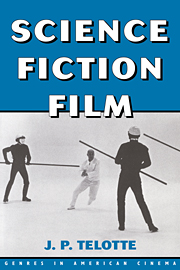Book contents
- Frontmatter
- Contents
- List of Illustrations
- Acknowledgments
- PART I APPROACHES
- PART II HISTORICAL OVERVIEW
- PART III FILM ANALYSES
- 4 The Science Fiction Film as Fantastic Text: THX 1138
- 5 The Science Fiction Film as Marvelous Text: Close Encounters of the Third Kind
- 6 The Science Fiction Film as Uncanny Text: RoboCop
- 7 Crossing Genre Boundaries/Bound by Fantasy: The Fly (1986)
- 8 Conclusion: A Note on Boundaries
- Notes
- Bibliography
- Select Filmography of the American Science Fiction Film
- Index
8 - Conclusion: A Note on Boundaries
Published online by Cambridge University Press: 03 December 2009
- Frontmatter
- Contents
- List of Illustrations
- Acknowledgments
- PART I APPROACHES
- PART II HISTORICAL OVERVIEW
- PART III FILM ANALYSES
- 4 The Science Fiction Film as Fantastic Text: THX 1138
- 5 The Science Fiction Film as Marvelous Text: Close Encounters of the Third Kind
- 6 The Science Fiction Film as Uncanny Text: RoboCop
- 7 Crossing Genre Boundaries/Bound by Fantasy: The Fly (1986)
- 8 Conclusion: A Note on Boundaries
- Notes
- Bibliography
- Select Filmography of the American Science Fiction Film
- Index
Summary
Throughout this study of the science fiction film we have repeatedly taken up questions of borders and boundaries, in part because all questions of identity, including those relating to film genres, immediately seem to call for an outline, a point of separation between one thing and another. Boundaries have traditionally made for easier discussion. At the same time, we should recognize that this issue is especially pertinent to any discussion of science fiction because its very subject matter – the reason–science–technology triad to which I have often referred in this book – typically focuses our attention on borders: the borders of our knowledge, those of our experience, those that separate us from what we often, from the vantage of today's thoroughly technologized society, might disparage as “nature.” Thus, in his discussion of the Western scientific tradition, Robert Romanyshyn describes our science and technology as tools that have created another sort of border by reconfiguring the human as “a spectator self ensconced behind its window” on the world. Certainly, moreover, the films we commonly place within the science fiction classification repeatedly visualize this boundary situation. Most obviously, the robot stands as a border figure between the human and the machine; the rocket, spaceship, or flying saucer is a tool for traversing the boundaries of space; the scientist, such as The Fly's (1986) Seth Brundle, holds the key to other knowledge, perhaps even other states of being.
- Type
- Chapter
- Information
- Science Fiction Film , pp. 197 - 204Publisher: Cambridge University PressPrint publication year: 2001



